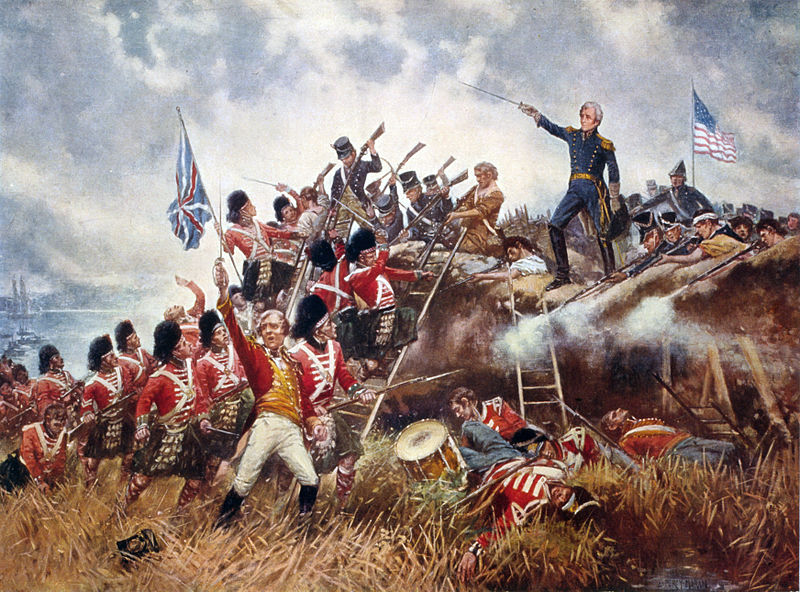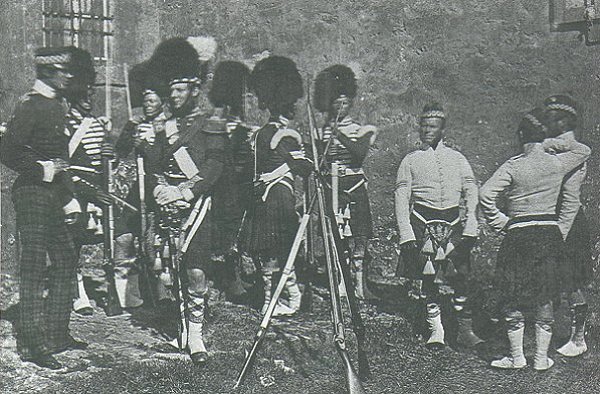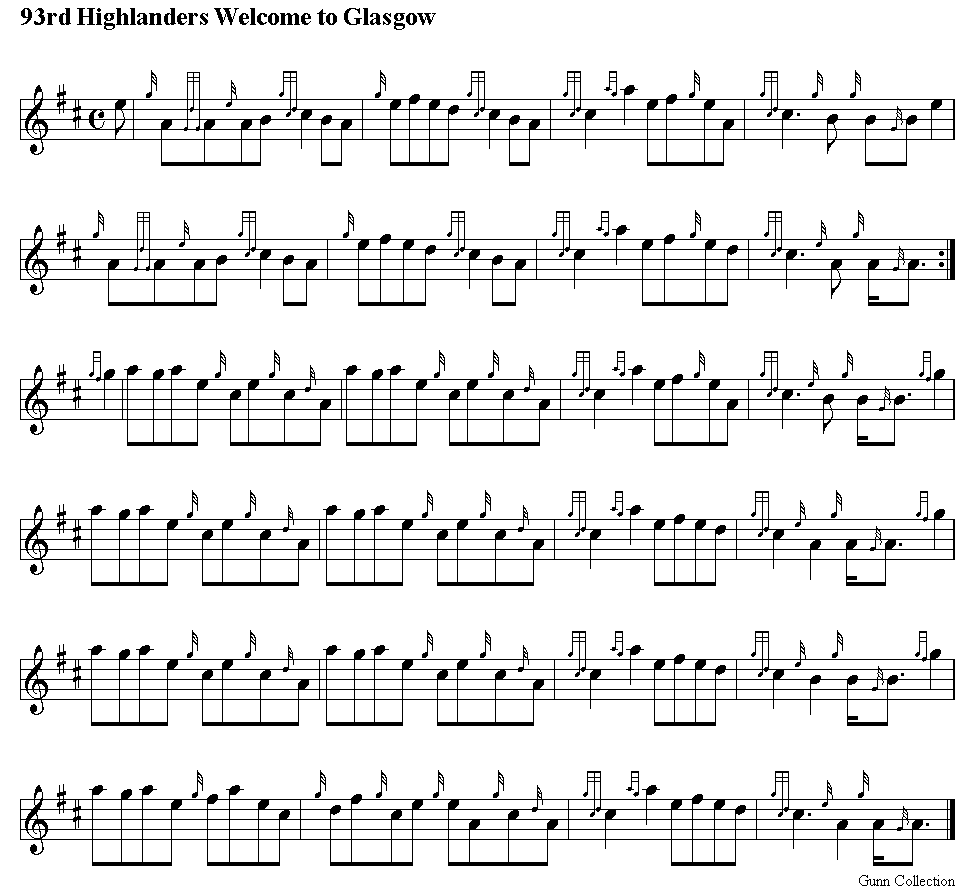|
The 93rd (Sutherland Highlanders)
Regiment of Foot was raised from the Sutherland
Fencibles by Major-General William Wemyss on behalf of
the Countess of Sutherland on 16 April 1799. The first
muster of the regiment took place at Skail in
Strathnaver in August 1800. One of the soldiers who
attended the muster was Sergeant Samuel Macdonald, a
soldier who stood six feet ten inches tall and had a
chest measuring 48 inches. The Countess of Sutherland,
on seeing Sergeant Macdonald, donated a special
allowance of 2 shillings 6 pence a day, and stated that
anyone as large as Macdonald "must require more
sustenance than his military pay can afford." According
to historian James Hunter, at a time when the Duke of
Wellington who was the British military's most eminent
commander could describe his soldiers as "the very scum
of the earth" who were eked out of precarious
livelihoods on the outermost margins of urban society,
the Highlanders of the 93rd Regiment of Foot, were, by
contrast, described as "the children of respectable
farmers"; "connected by strong ties of neighborhood and
even of relationship"; "a sort of family corps". Hunter
also noted that in an era when military order was
customarily maintained by regular floggings, one
Sutherland Highlander company went nineteen years
without having a single man punished. Thus it transpired
that the 93rd were a "highly valued, picture of military
discipline and moral rectitude".
The regiment was dispatched from Fort
George to Guernsey in September 1800. It returned to
Scotland in September 1802 from where it was deployed to
Dublin in February 1803 to assist in quelling an
insurrection. It was ordered to embark for Jamaica in
July 1805 but, after fortnight aboard ship, the orders
were canceled and the regiment sailed for the Cape of
Good Hope. It arrived at Table Bay in January 1806 and
joined the Highland Brigade which landed at Lospard Bay
with orders to capture Cape Colony from the Dutch forces
there. The regiment took part in the Battle of
Blaauwberg which led to the surrender of the Dutch
forces a few days later. It remained in the colony until
April 1814 when it embarked for home.
A second battalion was raised in
Inverness in May 1813. The 2nd Battalion was deployed to
Newfoundland in April 1814
but embarked for home in October 1815 and was
disbanded the following year.
Meanwhile, the 1st battalion embarked for North America
in September 1814 for service in the War of 1812. It
anchored at the entrance of Lake Borgne off the Gulf of
Mexico in December 1814 and then advanced up the left
bank of the Mississippi River towards New Orleans. It
came under fire from an American armed schooner on the
river and destroyed it. The regiment next saw action at
the Battle of New Orleans in January 1815. British
troops overran and captured the American position on the
right bank of river while, on the left bank where the
main assault occurred, a detachment of light infantry
companies including that of the 93rd Regiment of Foot,
captured the advance on the American right beside the
river. However, the British assault on the left bank
faltered and General John Keane led the main body of the
93rd Regiment of Foot diagonally across the field to
support the faltering British right flank attack near
the swamp. Following the death of Lieutenant Colonel
Robert Dale, the regiment's commanding officer, no
orders were issued either to advance or to withdraw so
the regiment stood fast and was mown down. General John
Lambert having taken command upon the death of General
Edward Pakenham finally sent orders to withdraw and
after a futile attempt to advance the regiment withdrew
from the field.

The regiment embarked for the West Indies
in November 1823. It was based in Barbados until
February 1826 when it moved to Antigua and Saint Kitts.
It embarked for home again in April 1834. New colors
were presented to the regiment by the Duke of Wellington
in October 1834. The regiment then moved to Dublin in
October 1835. It embarked to Canada in January 1838 to
service in the Patriot War: it landed in Halifax, Nova
Scotia in March 1838 and saw action at the Battle of the
Windmill in November 1838. It remained in Canada until
embarking for home in August 1848.

The regiment arrived at Stirling Castle
in October 1848 and provided a Guard of Honor for Queen
Victoria on her visit to Glasgow in August 1849. It
embarked for the Crimea for service in the Crimean War
in February 1854. As part of Brigadier-General Colin
Campbell's Highland Brigade, it took part in the Battle
of Alma in September 1854. On 25 October 1854, it was
stationed outside the British-controlled port of
Balaklava as part of its very thin defenses. The Russian
Army sent a large force to attack Balaklava,
precipitating the Battle of Balaclava. The Russian
threat was countered in part by the charge of General
James Scarlett's Heavy Cavalry Brigade but the rest of
the Russian force headed straight for the 93rd Regiment
of Foot.
Campbell told the men of the 93rd
Regiment of Foot as he rode down the line: "There is no
retreat from here, men...you must die where you stand."
One of the troops, John Scott, responded: "Ay, Sir
Colin. An needs be, we'll do that." As the younger
soldiers moved forward for a bayonet charge, Campbell
called out: "93rd, 93rd, damn all that eagerness!"
The Times journalist W.H.Russell commenting on the
action reported:
The
Russians dash at the Highlanders. The ground flies
beneath their horses' feet; gathering speed at every
stride, they dash on towards that thin red streak topped
with a line of steel.
This led
to the regiment's nickname: "The Thin Red Line".

The regiment also took part in the Siege
of Sevastopol in June 1855
before embarking for home in June 1856.
The regiment sailed for India in June
1857 to help suppress the Indian Rebellion.
As part of the Cardwell Reforms of the
1870s, where single-battalion regiments were linked
together to share a single depot and recruiting district
in the United Kingdom, the 93rd was linked with the 92nd
(Gordon Highlanders) Regiment of Foot, and assigned to
district no. 56 at Castlehill Barracks in Aberdeen. On 1
July 1881 the Childers Reforms came into effect and the
regiment amalgamated with the 91st (Argyllshire
Highlanders) Regiment of Foot to form the Argyll and
Sutherland Highlanders.
 |



